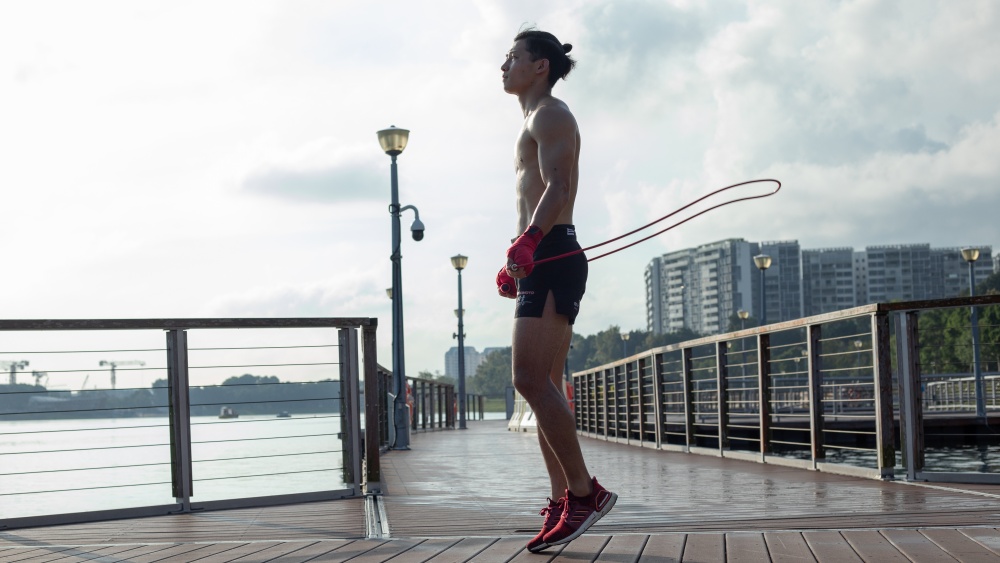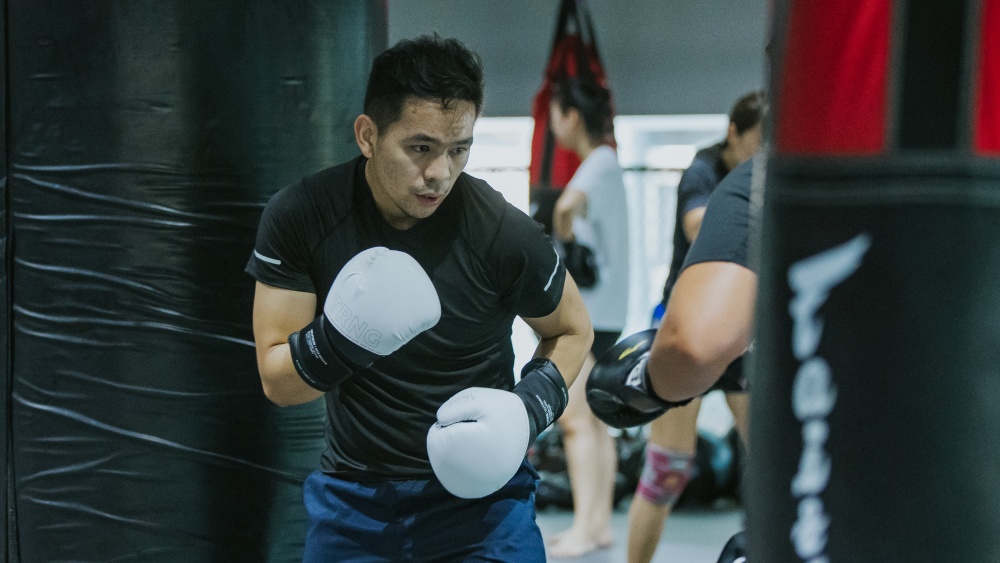Jumping rope, aka skipping, is one of the best options you have when it comes to improving both your boxing foot work and cardiovascular fitness simultaneously. These workouts are easy to perform and get your heart pumping and blood flowing. It also gives you a full body workout as it activates most muscles in your body.
Boxers often use jump rope as part of their warmups and main training programs, and you’ll need to train like they do to get the most out of your skipping sessions.
Benefits Of Skipping
Jumping rope helps build your mindset, athletic abilities, and overall fitness in ways only a few other workouts can compare. To help you better understand why boxers often choose to skip over other cardiovascular exercises, let’s take a look at some of its benefits:
- It improves your overall quickness and speed
- It gives you a full-body workout that targets most muscles in your body
- It gives you a mix of aerobic and anaerobic cardio, burning lots of calories in the process
- It makes you more powerful and explosive
- It enhances your reflexes and reaction time
- It trains you to be comfortable on the balls of your feet
- It improves your ability to move in different planes of space
- It makes you lighter on your feet
- It improves your body control and awareness
- It improves your hand-eye coordination
- It makes you more mindful
- It improves your ability to synchronize upper-body and lower-body movements
- Improves your rhythm, balance, coordination, and timing
You don’t get all these benefits when performing other cardio exercises like running and sprints. That’s why so many boxers make jump rope a significant part of their training. To make things even better, jump ropes are highly affordable and portable, so you can purchase one and take it anywhere you go. You can easily stuff it in an exercise or travel bag so you can always get some good cardio exercise whenever you want.
Choosing The Right Jump Rope For You
There are two main factors to consider when searching for the ideal jump rope for you: the type of rope and its length.
Type
There are various categories of jump ropes based on the material they are made from. The two most popular types are heavy and speed ropes. Heavy ropes have weights in their handles or rope, making them turn slower than other types of rope. They are designed to engage your upper body more when skipping. Speed ropes are lightweight ropes that are made for fast turns.
If you’re new to jumping rope, speed ropes are probably your best option. It’s the best for developing attributes like explosiveness, agility, quickness, and speed. Look for speed ropes made from plastics since they are typically more durable than leather and cotton alternatives. Plastic ropes also don’t drag in the air during your workouts.
Length
Jump ropes come in different lengths; the ideal length depends on your skipping abilities and height. Get a rope that’s too long, and you’ll end up dealing with more snaps and tangles due to poorer aerodynamics. Get one that’s too short for you, and you’ll be hunched over as you complete your reps.
A simple way to determine if a rope is the correct length for you is to step on the middle of the rope and pull its handles along the side of your torso, so the rope is taut and straight. If you’re new to skipping, you want the handles to reach your shoulders. The rope should clear your head by about a foot during your reps and barely graze the floor as you jump over it.
If you’re already advanced with jump ropes, you can use shorter ones that only reach your chest or upper hands. Shortening the rope enhances the benefits you get from your sessions since there’s less room for error. This forces your feet and hands to work faster, increasing the rope’s rotational speed. This improves your reaction time, reflexes, and total-body awareness.
Developing Your Jump Rope Routine
Once you’ve selected the right jump rope for your experience level, it’s time to create your jump rope routine. Some of the essential things you should consider when making your plans include:
Location
Where you perform your jump rope sessions determines how much stress it puts on your body. Skipping on solid surfaces like concrete or asphalt puts more stress on your body than skipping on softer surfaces with more give, like wood floors, grass, and exercise mats. Ideally, you want to perform most of your jump rope sessions on softer surfaces. Ensure you have enough room, so you don’t end up hitting obstacles or people as you try to get some work in.
Posture
Your body posture is another factor that impacts how much you get from your jump rope sessions. One of the most common mistakes people who are new to skipping make is using too much of their arms when performing their reps. Your wrists should propel the entire movement of the rope during the exercise, not your entire arms.
Another common mistake people new to skipping make is jumping too high during workouts. That doesn’t get you any extra benefits and increases the stress the exercise puts on your body. Watch one of Manny Pacquaio’s skipping videos, and you’ll notice he barely gets off the ground during his reps. That’s how professional boxers jump rope.
Popular Jump Rope Exercises
Some people assume skipping is monotonous, but that’s not true. There are so many different ways to skip; it’s only a matter of learning as many as you want. Once you do that, you can also vary the exercises you perform during your skipping sessions to keep things interesting.
The most basic jump used for skipping is the bounce step, which is jumping up and down with both feet. The second basic jump you should master before giving more advanced ones a try is the alternate-foot step, which looks like you’re running in place.
Some of the other foundational jumps you should learn if you want to jump rope like a professional boxer include:
- High Knees: High knees increase the intensity of the basic jump. It also makes your legs work harder while engaging your core and burning more calories. Simply lift your knees high when skipping to perform high knees.
- Bell Jumps: Bell jumps involve jumping forward and backward with both feet as you perform your revolutions. It helps to improve your agility.
- Boxer’s Heel-Toe Step: The heel-toe step involves alternating between landing on your heels and toes during your reps. One foot’s heel and the other’s toe should carry your weight after each jump. It’s great for your footwork and dance moves as it improves your foot coordination.
- Boxer’s Skip: The boxer’s skip is one of the more advanced jumps that might take you some time to master. It involves hopping as if you were in a boxing ring while skipping. When done correctly, only one foot should be on the ground at any point during your set. The boxer’s skip is an excellent exercise to condition your legs for boxing footwork.
- Front Saddle: This involves jumping in front and behind a line as you perform your set. It helps to enhance your agility.
- Skier Jump: Skier jumps are a lot like bell jumps, but instead of jumping forward and backward, you jump side to side as if you were a skier going down a hill.
- Side Straddle: The side straddle involves jumping to the left and right side of a line while you perform your reps. It also helps to improve your agility while making your legs work harder.
- Arm Side Swing: The arm side swing involves swinging the jump rope from side to side between your jumps. It engages your upper body more than other jumps.
- Foot Cross: This involves crossing your feet during your jumps. You bring your feet right to your left one jump, then do the reverse during your next jump. Keep alternating between these two moves until you’ve completed all of your jumps.
- Criss-Cross: This jump might look like one of the advanced ones, but it’s actually one of the easiest. Start with a basic jump and cross your arms and the rope every other jump. This variation improves your agility and hand-eye coordination. It also makes your shoulders do more work during your reps.
- Backward Jump: The backward jump involves moving the rope backward, so it comes down behind you. This variation helps to improve your timing, agility, and foot dexterity. It also reverses the angles your upper body’s muscles are engaged when skipping. It’s a fun way to add variation to your workouts, and it’s not as challenging as it looks once you get the timing down.
The jumps listed above are the foundation of many skipping workouts used by professional boxers are built upon. Learn each one, and you’ll never have a dull jump rope session.
You can make any of these jumps more challenging by performing power variations, which simply means swinging the rope at least twice underneath you before landing. Take your time to learn all these jumps and start incorporating them into your skipping sessions.
Some of the ways you can add skipping to your workout routine include:
1) Warmups
https://www.youtube.com/watch?v=kt-4pM4uzPM
Many boxers start their training camps seriously overweight, and exercises like jumping rope help them to get back into shape. Simply adding jump rope sessions to the start of your boxing workouts trims and strengthens your entire body. About ten to twenty minutes of non-stop skipping at a moderate pace is more than enough to prepare your body for more strenuous physical activities like heavy bag drills.
2) Cardio Training
Skipping can also work as your main cardiovascular activity. About three sets of 10-minute skipping with two-minute breaks between sets burn up to 600 calories. That’s a pretty good burn for 30 minutes of cardio. It’s more than you’d get from 30 minutes of high-intensity activities like high-intensity interval training (HIIT). There’s also nothing stopping you from getting more sets in and burning more calories. Every ten minutes skipping at a moderate pace burns up to 200 calories.
3) Fight Preparation
Professional boxers often use their jump rope sessions to mimic the intense demands of professional boxing matches. A professional boxing match at the highest levels involves 12 three-minute rounds with one-minute breaks between them. You can structure your skipping sessions just like a professional boxing match by following the same format. You can make things more challenging by alternating between three-minute skipping rounds and one-minute break periods where you skip at a slow pace.
4) High-Intensity Training Circuits
You can burn more calories by performing high-intensity training circuits while working on your boxing technique. Here’s a sample boxing circuit:
- Jump rope for two minutes at high intensity
- Shadowbox for a minute
- Rest for 30 seconds
- Alternate right and left hooks on a heavy bag for two minutes, hitting the bag as hard as you can
- Perform lunges for a minute, alternating legs
- Rest for a minute
- Jump rope for two minutes
- Work on a double-ended bag for a minute
- Shadowbox for a minute
There are no limits when it comes to creating your own circuits. Just add different jumps you can do with drills you perform at the boxing gym. Try to structure your circuits to give you active rest as you go through them, meaning you’re not targeting the same muscle groups with consecutive exercises.
Aim to perform jump rope training at least three times weekly to get the most out of them. Stick to once or twice a week if you’re just starting out to allow your body to adapt to the additional stress. Gradually build up your stamina until you can train a few times per week.
Train Like A Professional Boxer
Looking for world-class boxing instruction? Attend one of Evolve’s complimentary introductory boxing classes to see firsthand what training with professional boxers is like.
Book your complimentary trial class with our World Champions below!
If you have any other questions regarding Evolve MMA and the programs we offer, you can get in touch with our membership executives at the following locations:
Evolve MMA (Far East Square)
26 China Street
Far East Square #01-01
Singapore 049568
Phone: (65) 6536 4525
Evolve MMA (Orchard Central)
181 Orchard Road
#06-01 Orchard Central
Singapore 238896
Phone: (65) 6536 4556
Evolve MMA (KINEX)
11 Tanjong Katong Road
#02-52 KINEX
Singapore 437157
Phone: (65) 6288 2293
Evolve MMA (Clarke Quay Central)
6 Eu Tong Sen Street
#04-18 Clarke Quay Central
Singapore 059817
Phone: (65) 6226 2150
Evolve MMA (Star Vista)
1 Vista Exchange Green
#02-26A The Star Vista
Singapore 138617
Phone: (65) 6539 9590

















